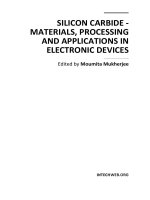Silicon Carbide Materials Processing and Applications in Electronic Devices Part 14 doc
Bạn đang xem bản rút gọn của tài liệu. Xem và tải ngay bản đầy đủ của tài liệu tại đây (3.87 MB, 35 trang )
Application of Silicon Carbide in Abrasive Water Jet Machining
445
(d) Pressure 40 psi
Fig. 14. Contamination at different zones and at different pressures.
Graph of Contamination vs Zone for Experiment 10
7
4
6
0
1
2
3
4
5
6
7
8
01234
Zone
Contamination
Graph of Contamination vs Zone for Experiment 9
4
8
4
0
1
2
3
4
5
6
7
8
9
01234
Zone
Contamination
Graph of Contamination vs Zone for Experiment 11
10
23
12
0
5
10
15
20
25
01234
Zone
C ontam in ation
Graph of Contamination vs Zone for Experiment 12
8
5
6
0
1
2
3
4
5
6
7
8
9
01234
Zone
Contamination
Silicon Carbide – Materials, Processing and Applications in Electronic Devices
446
Experiment 5 Zone A Zone B Zone C
Pressure : 30
kpsi
Flow rate : 5 g/s
Feed rate :
20mm/min
Contaminations
6 3 7
Experiment 6 Zone A Zone B Zone C
Pressure : 30
kpsi
Flow rate : 10
g/s
Feed rate : 10
mm/min
Contamination
5 6 6
Experiment 13 Zone A Zone B Zone C
Pressure : 40
kpsi
Flow rate : 5 g/s
Feed rate : 40
mm/min
Contamination
17 10 18
Experiment 16 Zone A Zone B Zone C
Pressure : 40
kpsi
Flow rate : 20
g/s
Feed rate : 10
mm/min
Contamination
11 4 6
Table 2. Embedding of the abrasives
Application of Silicon Carbide in Abrasive Water Jet Machining
447
5.1 Comparison of SiC with other abrasives in AWJM
In order to compare the capability of SiC with other abrasives, glass was taken as the work
material. The main properties of glass are: hardness- 600 knoops, density- 2200 kg/m
3
,
tensile strength- 70 MN/m
2
and specific heat capacity- 750 J/kg
o
C. Three types of abrasives
used in the present study were garnet, Al
2
O
3
and SiC. Their hardness is 1350 knoops, 2100
knoops and 2500 knoops respectively. Experiments were conducted on a water jet machine
WJ 4080. The machine was equipped with a controller type 2100 CNC Control. The nozzle
used for the abrasive water jet was made of carbide with the orifice diameter of 0.1 mm. The
jet was perpendicular to the work surface. The abrasive water jet in cutting process is shown
in Fig. 15. After the cutting process the top width and the bottom width of the slot was
measured using an optical microscope Mitutiyo Hismet II.
Fig. 15. Experimental set-up
5.2 Effect of different cutting parameters on taper of cut
Taper of cut was calculated according to the mathematical expression; T
R
= (b – a)/2, where
T
R
, b
and a are taper of cut, top width of cut and the bottom width of the cut respectively.
Experimental investigations showed that during AWJM with different abrasives, the width
of cut at the top of the slot was always greater than that at the bottom of the slots. It was
explained by Wang et al., 1999 that as the abrasive particles move down the jet, they lose
their kinetic energy and the relative strength zone of the jet is narrowed down. As a result,
the width of cut at the bottom of the slot is smaller than that at the top. Influence of standoff
distance (SOD) of the jet from the target material on the taper of cut during AWJM with
different types of abrasives is illustrated in Fig. 16. It can be observed that the garnet
abrasives produced the largest taper of cut followed by Al
2
O
3
and SiC abrasives. Among the
three types of abrasives used, SiC is the hardest material and consequently it retains its
cutting ability as it moves down. Therefore, the difference between the widths at the top and
bottom of the slot is small and consequently, the taper angle is also smaller. On the other
hand, garnet abrasives lose their sharpness and as a result the bottom width becomes much
narrower than the top width. Fig. 16 also shows that for all kinds of abrasives, the taper of
cut increases with SOD. This is due to the divergence shape of the jet. As SOD is increased,
the jet focus area also increases resulting increase in the width of cut.
Silicon Carbide – Materials, Processing and Applications in Electronic Devices
448
Influence of SOD on taper of cut
0
0.05
0.1
0.15
0.2
0.25
0246
SOD (mm)
Taper of cut
Aluminum
oxide
SiC
garnet
Fig. 16. Influence of SOD on taper of cut
Influence of w ork feed rate on taper of cut
0
0.05
0.1
0.15
0.2
0.25
0.3
0 204060
work feed rate (mm/min)
taper of cut
Aluminum
oxide
SiC
Garnet
Fig. 17. Influence of feed rate on taper of cut
Fig. 17 shows the relationship between work feed rate and taper of cut during AWJM using
different abrasive materials. For all types of abrasives the taper of cut shows an increasing
trend with increase in work feed rate. With increase in work feed rate the machining zone is
exposed to the jet for a shorter time. Cutting process is less effective at the jet exit that results
an increase in taper of cut. Conner & Hashish, 2003 also found similar effect of feed rate on
taper of cut during AWJM of aerospace materials using garnet abrasives. Garnet abrasives
demonstrate a high taper of cut followed by SiC and Al
2
O
3
.
Influence of pressure on taper of cut is illustrated in Fig. 18. Taper of cut decreases with
increase in jet pressure for all the types of abrasives used. At a higher pressure the abrasives
have higher energy and they retain their cutting ability as they move down from the jet
Application of Silicon Carbide in Abrasive Water Jet Machining
449
entrance to the jet exit. As a result, taper of cut reduces with increase in jet pressure. Louis et
al., 2003 indicates some other positive aspects of using higher pressure. He found that the
depth of penetration of the jet increases and cutting efficiency improves with increase in
pressure. On the other hand, abrasive flow rate can be reduced if the jet pressure is
increased. However, taper of cut is smaller for SiC abrasives followed by Al
2
O
3
and garnet.
SiC abrasives being harder than Al
2
O
3
and garnet abrasives retain their sharp edges both at
the entrance and the exit of the jet and produce the smallest width of cut. On the other hand,
garnet abrasives being comparatively softer lose the sharpness of their cutting edges when
they are near the jet exit.
Influence of pressure on taper of cut
0
0.05
0.1
0.15
0.2
0.25
0204060
Jet pressure (ksi)
Taper of cut
Aluminum
oxide
SiC
garnet
Fig. 18. Effect of pressure on taper of cut
Influence of SOD on average width of cut
0
0.5
1
1.5
2
2.5
0246
SOD (m m )
average width od cut
(mm)
Aluminum
oxide
SiC
garnet
Fig. 19. Effect of SOD on taper of cut
Silicon Carbide – Materials, Processing and Applications in Electronic Devices
450
5.3 Effect of different parameters on average width of cut
It has been established that though the abrasive water jet is a divergent one, the effective
cutting zone of the jet is convergent, since the abrasives at the outer zone of the jet lose their
kinetic energy. As a result, the width of cut at the jet entrance is always greater than the
same at the jet exit. In Fig. 19 to Fig. 21 the average value of the widths of the jet entrance
and jet exit has been taken as the width of cut. From Fig. 19 it is obvious that the average
width of cut increases with increase in SOD which is due to the divergence shape of the jet.
It was found that SiC produced the widest slot followed by Al
2
O
3
and garnet. This is by
virtue of higher hardness of SiC that enables more effective material removal.
Influence of feed rate on average w idth of cut
0
0.5
1
1.5
2
2.5
0 204060
Work feed rate (mm/min)
Avarage width of cut
(mm)
A
luminu
m
oxide
SiC
Garnet
Fig. 20. Effect of feed on width of cut
Influence of pressure on average w idth of cut
0
0.5
1
1.5
2
2.5
0 204060
jet pressure (ksi)
average width of cut (mm)
Aluminum
oxide
SiC
garnet
Fig. 21. Effect of pressure on width of cut
Influence of work feed rate on the average width of cut is illustrated in Fig. 20. Average
width of cut decreases with increase in work feed rate since with the increase in feed rate the
Application of Silicon Carbide in Abrasive Water Jet Machining
451
work is exposed to the jet for a shorter period. The effect of pressure on average width of cut
during AWJM is shown in Fig. 21. A higher pressure produces a jet of higher energy with
capability of more effective cutting. From Fig. 19, Fig. 20 and Fig. 21 it was observed that in
all the cases the average width of cut produced by SiC was higher than those produced by
Al
2
O
3
and garnet abrasives. It can be concluded that hardness is a key property of abrasive
materials.
6. Conclusions
From the above discussions it can be concluded that during AWJM of carbides using SiC
abrasives, machined surface roughness reduces if the jet pressure is increased. Surface
smoothness deteriorates from the top of cut towards the exit of cut. The roughness of cut
surface reduces with increase in abrasive flow rate since more abrasives are available per
unit area of cut. The lower most zone of the cut surface is the most contaminated zone
followed by the top most zone and the middle zone. Taper of cut increases with increase in
SOD. Garnet abrasives produce a larger taper of cut followed by Al
2
O
3
and SiC. This is due
to higher hardness of SiC compared to Al
2
O
3
and garnet. Taper of cut also increases with
increase in work feed rate. But taper of cut reduces with increase in pressure. A higher
pressure increases the kinetic energy of the abrasives and the divergence of the jet is
reduced that causes a decrease in taper of cut. An increase in SOD increases the focus area of
the jet and increases the average width of cut. But increase in feed rate reduces the average
width of cut since the surface to be cut is exposed to the jet for a shorter time. A higher jet
pressure increases the kinetic energy of the abrasive particles and enhances their cutting
ability. As a result, increase in pressure causes increase in the average width of cut. SiC is
harder than Al
2
O
3
and garnet. As a result, its cutting ability is also higher than that of Al
2
O
3
and garnet. Therefore, the average width of cut produced by SiC is higher than those
produced by Al
2
O
3
and garnet.
7. Acknowledgement
The authors of this work are indebted to the Research Management Center, International
Islamic University Malaysia (IIUM) for its continuous help during the research work. The
author is also grateful to Momber W. & Kovacevic, R. (1998), since some information has
been taken from their book.
8. References
Chen F., Patel K., Siores E. & Momber A. (2002). Minimizing particle contamination at
abrasive water jet machined surfaces by a nozzle oscillation technique.
International Journal of Machine Tools & Manufacture, Vol. 42, pp. 1385–1390, ISSN
0890-6955
Chacko, V.; Gupta, A. & Summers, A. (2003). Comparative performance study of
polyacrylamide and xanthum polymer in abrasive slurry jet,
Proceedings of
American Water Jet Conference, Houston, Texas, USA [3] Hocheng, H. & and
Chang, R. (1994). Material removal analysis in abrasive water jet cutting of
ceramic plates.
Journal of Materials Processing Technology, Vol. 40, pp. 287-304,
ISSN 0924-0136
Silicon Carbide – Materials, Processing and Applications in Electronic Devices
452
Conner, I & and Hashish, M. (2003). Abrasive water jet machining of aerospace structural
sheet and thin plate materials.
Proceedings of American water Jet Conference, Houston,
Texas, USA
Kalpakjian, S. & Schmid, R. (2010). Manufacturing Engineering and Technology, Pentice
Hall, ISBN 978-981-06-8144-9, Singapore
Keyurkumar, P. (2004). Quantitative Evaluation of Abrasive Contamination In Ductile
Material During Abrasive Water Jet Machining And Minimizing With A Nozzle
Head Oscillation Technique.
International Journal of Machine Tools & Manufacture,
Vol. 44, pp. 1125-1132, ISSN 0890-6955
Louis, H.; Mohamed, M. & Pude, F. (2003). Cutting mechanism and cutting efficiency for
water pressures above 600 MPa.
Proceedings of American Water Jet Conference,
Houston, Texas, USA
Momber, W.; Eusch, I & Kovacevic, R. (1996). Machining refractory ceramics with abrasive
water jet.
Journal of Materials Science, Vol. 31, pp. 6485-6493, ISSN 0022-2461
Momber W. & Kovacevic, R. (1998).
Principles of Abrasive Water Jet Machining, Springer, ISBN
3540762396, London
Mort, A. (1995). Results of abrasive water jet market survey,
Proceedings of 8
th
American Water
Jet Conference, Vol. 1, pp. 259-289, Houston, Texas, USA
Siores, E.; Chen, L.; Lemma, E. & Wang, J. (2006). Optimizing the AWJ Cutting Process of
Ductile Materials Using Nozzle Oscillation Technique,
International Journal of
Machine Tools & Manufacture.
Vol.42, pp. 781–789, ISSN 0890-6955
Wang, J. & Wong, K. (1999). A study of abrasive water jet cutting of metallic coated sheet
steel.
International Journal of Machine Tools and Manufacture, Vol. 39, pp. 855-870,
ISSN 0890-6955
Waterjet machining tolerances, 2011, Available from
19
Silicon Carbide Filled Polymer Composite for
Erosive Environment Application:
A Comparative Analysis of Experimental and
FE Simulation Results
Sandhyarani Biswas
1
, Amar Patnaik
2
and Pradeep Kumar
2
1
Department of Mechanical Engineering, National Institute of Technology, Rourkela,
2
Department of Mechanical Engineering, National Institute of Technology, Hamirpur,
India
1. Introduction
Polymer composites form important class of engineering materials and are commonly used
in mechanical components. Because of their high strength-to-weight and stiffness-to-weight
ratios, they are extensively used for a wide variety of structural applications as in aerospace,
automotive, gear pumps handling industrial fluids, cams, power plants, bushes, bearing
cages and chemical industries. Whereas, wear performance in nonlubricated condition is a
key factor for the material selection and fabrication procedure (Hutchings, 1992). Glass fiber
reinforced polymer composites traditionally show poor wear resistance due to the brittle
nature of the fibers. Many researchers have been reported on the effect of fiber, filler and
matrix materials so far in the literature regarding economical and functional benefits to both
consumers and industrial manufacturers (Budinski, 1997; Chand et al., 2000; Tripathy and
Furey, 1993). The addition of hard particulate ceramic fillers not only improves the wear
performance of the particulate filled polymer composites but also reduce the cost of the
composites. In order to obtain improve wear performances many researchers modified
polymers using different fillers (Briscoe et al. 1974; Tanaka 1986; Bahadur et al, 1994;
Bahadur and Tabor,1985; Kishore et al. 2000; Wang et al. 2003).
Silicon carbide (SiC) is one such ceramic material that has great potential for overcoming the
current inadequacies of abrasive products due to its inherent characteristic of being
chemically inert and consequently resistant to improve mechanical and wear resistance
material. It has an excellent abrasive nature and has been produced for grinding wheels and
other for more than hundred years. Now-a-days the material has been developed into a high
quality technical grade ceramic with very good mechanical properties. It is used in
abrasives, ceramics, refractories, and other high-performance applications. Silicon carbide is
composed of tetrahedra of carbon and silicon atoms with strong bonds in the crystal lattice.
This produces a very strong material and not attacked by any acids or alkalis or molten salts
up to 800°C (Nordsletten et al. 1996).
To this end, the present research work is undertaken to develop a new class of glass fiber
based polymer composite filled with SiC particulate and study the effect
of various
Silicon Carbide – Materials, Processing and Applications in Electronic Devices
454
operational variables, material parameters and their interactive influences on erosive wear
behavior of these composites. A finite element (FE) model (AUTO-DYN) of erosive wear is
established for damage assessment and validated by a well designed set of experiments. The
eroded surfaces of these composites are analyzed with scanning electron microscopy (SEM),
and the erosion wear mechanisms of the composites are investigated.
2. Experimental
2.1 Preparation of composites
In this study, short E-glass fiber with 6mm length (Elastic modulus of 72.5 GPa and density
of 2.59 gm/cc) is taken to prepare all the particulate filled (SiC) glass fiber reinforced
polyester composites. The unsaturated isophthalic polyester resin (Elastic modulus 3.25GPa
and density 1.35gm/cc) is manufactured by Ciba Geigy and locally supplied by Northern
Polymers Ltd. New Delhi, India. The composite fabricated in two different parts. One part
having different fiber loading with varying the fiber weight fraction from 10wt% to 50wt%
at an increment of 10wt% and the second part, SiC filled short glass fiber reinforced
polyester resin with three different percentages (0wt%, 10wt% and 20wt% of SiC). The
mixture is poured into various moulds conforming to the requirements of various testing
conditions and characterization standards. The entrapped air bubbles (if any) are removed
carefully with a sliding roller and the mould is closed for curing at a temperature of 30°C for
24 h at a constant pressure of 10 kg/cm
2
.
2.2 Air-jet erosion tester
The solid particle erosion test rig as per ASTM G76 used in the present study consists of an
air compressor, a particle feeder, an air particle mixing chamber and accelerating chamber.
The equipment was designed to feed erodent particles into a high velocity air stream, which
propelled the particles against the specimen surface (Strzepa et al., 1993; Routbort et al.,
1981). The erodent particles entrained in a stream of compressed air and accelerated down
to a 65mm long brass nozzle with 3mm inside diameter to impact on a specimen mounted
on an angle fixture. The velocity of the eroding particles is determined using rotating disc
method (Ruff and Ives, 1975). The steady state erosion rate was determined by weighing the
sample before and after the end of each test. While the impingement angles ranges from 30°
to 90° and the test duration was 20min for each run. The erodent used for this test was river
silica sand particle of three different sizes, i.e. 250, 350 and 450μm. The sample was cleaned
with a blast of compressed air before each weighing to remove all loosely adhering debris.
The mass loss from the target was measured with an analytical balance of ±0.01mg accuracy.
The process is repeated every 10 minutes till the erosion rate attains a constant value called
steady-state-erosion-rate. Finally, the worn surfaces of some selected samples are examined
by scanning electron microscope JEOL JSM-6480LV.
2.3 Finite element model
In the present work, the erosive wear processes are modeled using an explicit dynamic code
ANSYS/AUTO-DYN. The eight-node brick hexahedral elements with one integration point
are used in the 3D simulation. The mesh is refined to a standard cubic element in order to
calculate the erosion rate at the targeted area on the composites. It has been studied in
literature that simulating a single particle was not sufficient to get valid results therefore
subsequently considered three or more particles were needed to simulate the erosion
Silicon Carbide Filled Polymer Composite for Erosive Environment
Application: A Comparative Analysis of Experimental and FE Simulation Results
455
process instead of single particle (ElTobgy et al., 2005). In this study, 125 spherical shaped
particles were used to ensure the accuracy of the proposed model. All the particles are
striking the target area at random locations. There are 10 groups which contain 125 particles
aggregately in the proposed model.
(a) (b)
(c) (d)
Fig. 1. Schematic diagram of target composite material and nozzle (a: 30° impingement
angle, b: 45° impingement angle, c: 60° impingement angle and d: 90° impingement
angle)
Silicon Carbide – Materials, Processing and Applications in Electronic Devices
456
Each group has 12 particles which would impact the surface simultaneously and followed
by another simultaneous particles group, and so on. According to the researchers, the
distance between any two particles’ centers in the same group is no less than 0.6r (r is the
radius of the particles) to avoid the damage interaction (Woytowitz and Richman, 1999). The
finite element model of the target material and simulated nozzle is shown in Figure 1. For
the particles, the rotation degrees of freedom are constrained. Generally, the erosion rate
(g/g) was used to characterize the erosion performance of the target materials.
2.4 Taguchi experimental design
Taguchi method is a statistical tool for the purpose of designing experimental procedure
and mainly improving product quality. It uses the orthogonal array to set up the experiment
for the advantages of less number and optimizes the process parameters by the analysis of
signal-to-noise (SN) ratio. Taguchi method has become a powerful analysis tool for
improving the experimental results to get high quality at low cost (Peace, 1993; Phadke,
1989). Therefore, a large number of factors are included so that non-significant variables can
be identified at earliest opportunity. The impact of five such parameters are studied using
L
27
(3
13
) orthogonal design. The operating conditions under which wear tests are carried out
are given in Table 1. In conventional full factorial experiment design, it would require 3
5
=
273 runs to study five parameters each at three levels whereas, Taguchi’s factorial
experiment approach reduces it to only 27 runs offering a great advantage in terms of
experimental time and cost. The experimental observations are further transformed into
signal-to-noise (S/N) ratio. There are several S/N ratios available depending on the type of
performance characteristics. The S/N ratio for minimum wear rate can be expressed as
“lower is better” characteristic, which is calculated as logarithmic transformation of loss
function as shown below (Peace, 1993).
Smaller is the better characteristic:
S1
2
10log Y
Nn
=−
(1)
where, n the number of observations and y the observed experimental data.
The plan of the experiments is as follows: the first column is assigned to impact velocity (A),
the second column to SiC content (B), the fifth column to impingement angle (C), the ninth
column to stand-off distance (D) and the tenth column to erodent size (E), the third and
fourth column are assigned to (A× B)
1
and (A×B)
2
respectively to estimate interaction
between impact velocity (A) and SiC content (B), the sixth and seventh column are assigned
to (B× C)
1
and (B×C)
2
respectively to estimate interaction between the SiC content (B) and
impingement angle (C), the eight and eleventh column are assigned to (A× C)
1
and (A×C)
2
respectively to estimate interaction between the impact velocity (A) and impingement angle
(C) and the remaining columns are used to estimate experimental errors. The output to be
studied is erosion rate (E
r
) and the tests are repeated twice corresponding to 54 tests.
Furthermore, a statistical analysis of variance (ANOVA) is performed to identify the process
parameters that are statistically significant. With the S/N and ANOVA analyses, the optimal
combination of the process parameters can be predicted to a useful level of accuracy. Finally,
a confirmation experiment is conducted to verify the optimal process parameters obtained
from the parameter design.
Silicon Carbide Filled Polymer Composite for Erosive Environment
Application: A Comparative Analysis of Experimental and FE Simulation Results
457
Control factor
Level
I II III Units
A:Impact velocit
y
43 54 65 m/sec
B: SiC content 0 10 20 %
C:Im
p
in
g
ement an
g
le 30 60 90 De
g
ree
D:Stand-off distance 65 75 85 mm
E:Erodent size 250 350 450 µm
Table 1. Levels for various control factors
3. Results and discussion
3.1 Erosive wear of the composites
The results have been organized and discussed in two sections. Firstly, the steady state
erosion characteristics of the composites are determined for selected level of optimally
controlled operating variables and compared the steady state results with the simple finite
element simulation results to observe the variations in erosion rate with respective to
impingement angle and the next, simulations results have been analyzed under Taguchi’s
experimental technique.
3.2 Steady state erosion rate
3.2.1 Influence of impingement angle
Solid-particle erosion is a complex wear phenomena influenced by a number of control
factors such as impact velocity, angle of impingement, erodent particle size, stand-off-
distance, materials properties, erodent particles geometry and environment temperature etc.
Among these, impingement angle is the one of the most important parameter and widely
studied parameter in the erosion study of materials (Hutchings, 1992; Tsuda et al., 2006).
The erosion rate is measured of function of impingement angle, two types of material
behavior generally observed in the target material i.e. ductile and brittle nature. The ductile
nature of materials is characterized by maximum erosion rate at acute angle (15-30°) and for
brittle behavior of materials, the maximum erosion rate is observed at normal impingement
angle (90°). But as far as polymer matrix composites are concerned the composite materials
show versatile in nature depending upon the fabrication procedure and type of reinforcing
material. The reinforced composites show a semi-ductile behavior having the maximum
erosion rate in the range of 45-60°
(
Hutchings, 1992), unlike the above two categories. This
classification, however, is not absolute as the erosion of material has a strong dependence on
erosion conditions such as the properties of target material.
In the present study of SiC filled glass fiber-polyester composites, the erosion rate increases
monotonically with the increase in impingement angle and reaches maximum at 45°
impingement angle for particulate filled composites. However, for unfilled composite the
maximum erosion rate is found to be at 60° impingement angle. This indicated that all the
particulate filled and unfilled composites show semi-ductile erosion behaviour irrespective of
filler content. Similarly, the finite element analysis simulated results are in good agreement
with the experimental results as observed in Figure 2. As far as erosion resistance is concerned
20wt% SiC filled composites show better erosion resistance among other particulate filled and
unfilled composites. Whereas, unfilled composites shows maximum erosion rate as compared
with 10wt% and 20wt% SiC filled glass fiber reinforced polyester composites both in
experimental and finite element analysis simulated results as shown in Figure 2.
Silicon Carbide – Materials, Processing and Applications in Electronic Devices
458
30 45 60 75 90
5.0x10
-4
1.0x10
-3
1.5x10
-3
2.0x10
-3
2.5x10
-3
3.0x10
-3
3.5x10
-3
4.0x10
-3
Erosion rate (g/g)
Impingement angle (Degree)
20wt% SiC (Expt.result)
20wt% SiC (FEM result)
10wt% SiC (Expt.result)
10wt% SiC (FEM result)
0 wt% SiC (Expt.result)
0 wt% SiC (FEM result)
(Impact velocity: 43 m/sec, stand-off distance: 75mm and erodent size: 450μm)
Fig. 2. Influence of impingement angle on erosion rates of composites
3.2.2 Influence of impact velocity
Similarly, the variation of erosion rate of unfilled and SiC filled composites with impact
velocity is shown in Figure 3. Erosion trials are conducted at five different impact velocities.
40 45 50 55 60 65
5.0x10
-4
1.0x10
-3
1.5x10
-3
2.0x10
-3
2.5x10
-3
3.0x10
-3
Erosion rate (g/g)
Impact velocity (m/sec)
0 wt% SiC
10wt% SiC
20wt% SiC
(Impingement angle: 60°, stand-off distance: 75mm and erodent size: 450μm)
Fig. 3. Influence of impact velocity on erosion rates of composites
It is seen, in the Figure 3 that for all the composite samples, the erosion rates gradually
increases with the increase in impact velocity from 43m/sec to 65m/sec respectively. The
Silicon Carbide Filled Polymer Composite for Erosive Environment
Application: A Comparative Analysis of Experimental and FE Simulation Results
459
increase in erosion rate with increase in impact velocity can be attributed to increased
penetration of particles on impact as a result of dissipation of greater amount of particle
thermal energy to the target surface. This leads to more surface damage, enhanced sub-
critical crack growth etc. and consequently to the reduction in erosion resistance.
3.3 Taguchi analysis and response optimization
The analysis is made using the computational software MINITAB 15. Table 2 shows the
experimental design using L
27
orthogonal array. The overall mean for the S/N ratio of
erosion rate is found to be 61.92db for erosion rate is mentioned in the response table.
Expt.
No.
Impact
Velocity
(A)(m/s)
SiC
content
(B) (%)
Impingement
angle
(C) (Degree)
Stand-off
Distance
(D)(mm)
Erodent
size (E)
(µm)
Erosion
rate (Er)
(g/g)
S/N
Ratio
(db)
1 43 0 30 65 250 0.0003303 69.6224
2 43 0 60 75 350 0.0002466 72.1588
3 43 0 90 85 450 0.0001246 78.0908
4 43 10 30 75 350 0.0004458 67.0165
5 43 10 60 85 450 0.0002775 71.1347
6 43 10 90 65 250 0.0023721 52.4974
7 43 20 30 85 450 0.0006133 64.2461
8 43 20 60 65 250 0.0003333 69.5424
9 43 20 90 75 350 0.0006175 64.1873
10 54 0 30 75 450 0.0014625 56.6981
11 54 0 60 85 250 0.0028121 51.0194
12 54 0 90 65 350 0.0027000 51.3727
13 54 10 30 85 250 0.0000917 80.7558
14 54 10 60 65 350 0.0022625 52.9082
15 54 10 90 75 450 0.0027392 51.2476
16 54 20 30 65 350 0.0005450 65.2721
17 54 20 60 75 450 0.0001229 78.2078
18 54 20 90 85 250 0.0007804 62.1535
19 65 0 30 85 350 0.0024783 52.1171
20 65 0 60 65 450 0.0045143 46.9082
21 65 0 90 75 250 0.0031857 49.9359
22 65 10 30 65 450 0.0004354 67.2217
23 65 10 60 75 250 0.0009611 60.3442
24 65 10 90 85 350 0.0004091 67.7625
25 65 20 30 75 250 0.0002840 70.9336
26 65 20 60 85 350 0.0034362 49.2785
27 65 20 90 65 450 0.0035105 49.0927
Table 2. Experimental design using L
27
orthogonal array
Silicon Carbide – Materials, Processing and Applications in Electronic Devices
460
The Effect of control factors on erosion rate is shown in Figure 4. It is observed from
response graph that the combination of factors settings are A
1
, B
3
, C
1
, D
3
and E
1
have been
found to be the optimum factor level for the erosion rate is concerned on the basis of
smaller-the-better characteristics. The corresponding interaction graphs are plotted in the
Figures 5a-c.
655443
69
66
63
60
57
20100 906030
857565
69
66
63
60
57
450350250
A
Mean of SN ra tios
B C
D E
Main Effects Plot for SN ratios
Data Means
Signal-to-noise: Smaller is better
Fig. 4. Effect of control factors on erosion rate
Silicon Carbide Filled Polymer Composite for Erosive Environment
Application: A Comparative Analysis of Experimental and FE Simulation Results
461
655443
75
70
65
60
55
50
A
SN ratios
0
10
20
B
Interaction Plot for SN ratios
Data Means
Signal-to-noise: Smaller is better
Fig. 5a. Interaction graph between factor A and factor B (A×B) for erosion rate
655443
70
65
60
55
50
A
SN ratios
30
60
90
C
Interaction Plot for SN ratios
Data Means
Signal-to-noise: Smaller is better
Fig. 5b. Interaction graph between factor A and factor C (A×C) for erosion rate
Silicon Carbide – Materials, Processing and Applications in Electronic Devices
462
20100
72.5
70.0
67.5
65.0
62.5
60.0
57.5
55.0
B
SN ratios
30
60
90
C
Interaction Plot for SN ratios
Data Means
Signal-to-noise: Smaller is better
Fig. 5c. Interaction graph between factor B and factor C (B×C) for erosion rate
3.4 Surface morphology
The erosion wear mechanisms of SiC filled glass fiber reinforced polyester composites eroded
surfaces are observed as per Taguchi experimental design by scanning electron microscopy
(SEM). Figure 6a and 6b shows the SEM of eroded composite sample studied at lower
impingement angle (see Table 2, Experiment 4). The random distribution of SiC fillers on the
composite surface and removable of matrix material on the composite surface are clearly
observed from the figures. Figure 6c shows the increase in erosion rate with higher impingement
angle (90°) for 10wt% of SiC filled glass-polyester composites (see Table 2, Experiment 6). Figure
6d shows a hole formed after SiC particle was removed from the surface. The inside surface of
the hole seemed very smooth and clear which indicated that SiC particles debonded from the
matrix surface with the propagation of interfacial cracks due in part to the poor interfacial bond
strength (see Table 2, Experiment 11). This is due to the increase in impact velocity from 43m/s to
54m/s and more energy to chip-off the target material.
Similarly Figure 6e and 6f show the fibers are protruded above the worn surface due to SiC
particles are removed from the upper surface of the composites. However, there is a
significant difference between Figures 6e and 6f due to the change in impingement angle
and change in impact velocity. Thus, after the removal of the matrix material, there could be
a layer of glass fiber and SiC particulates bonded on the matrix material. This indicated the
favorable effect of good interfacial bond strength on the wear performance for the
composites which helped prolong the lifetime of the SiC particulates to bear erosion and
protect the matrix material before it was removed away. It has been reported by few of
researchers that the impact on brittle materials at an oblique angle produced radial cracks at
an angle to the surface and they can contribute to only matrix material loss (Scattergood et
al., 1981; Lawn, 1993). Radial cracks can also contribute to material removal when they drive
through a relatively thin wall. In such a case, the material loss will occur without the
formation of a lateral crack. Due to the above wear mechanism the larger erodent produce
Silicon Carbide Filled Polymer Composite for Erosive Environment
Application: A Comparative Analysis of Experimental and FE Simulation Results
463
(a) (b)
(c) (d)
Removal of matrix materials
Expose of short glass fibers
Removal of matrix
materials
Silicon Carbide – Materials, Processing and Applications in Electronic Devices
464
(e) (f)
(g) (h)
Fig. 6. SEM micrographs of the eroded glass fiber-polyester composites filled with SiC
Silicon Carbide Filled Polymer Composite for Erosive Environment
Application: A Comparative Analysis of Experimental and FE Simulation Results
465
deeper radial cracks on the eroded surfaces. The tendency for material loss to occur from
radial cracking should increase with increase in erodent size (Lee et al., 2005; Milman et al.,
1999). However, with the increasing content of the SiC particles in the composites from
10wt% to 20wt%, the wear rate of the composites increased gradually, reached a maximum
and then declined gradually. With the further increase in impact velocity from 54m/sec to
65m/sec for 20wt% SiC filled short glass fiber reinforced polyester composites the material
removal on the surface is more but the erosion resistance become more as compared with
other particulate filled glass-polyester composites as shown in Figure 6g and 6h (see Table 2,
Experiment 25). In the present study, the matrix material is removed from the composite
surface due to continuous impact of erodent particles with sharp angles and high impact
velocity, but the reinforcing glass fibers and SiC particulates are removed slowly then the
matrix material. This may be due to the inclusions of high hardness of SiC particles.
3.5 ANOVA and the effects of factors
The results of the experimental trials were investigated using the ANOVA statistical
analysis method. Table 3 shows the results of the ANOVA with the erosion rate (E
r
) for
SiC filled short glass fiber reinforced polyester composites. The objective of ANOVA is to
analyze the influence of impact velocity (A), SiC content (B), impingement angle (C),
stand-off distance (D) and erodent size (E) on the total variance of the results. This
analysis was undertaken for a level of significance of 5% that is for a level of confidence of
95%.
From Table 3, it is concluded that impact velocity (p = 0.191), impingement angle (p = 0.365),
stand-off distance (p = 0.470) and SiC content (p = 0.539) have great influence on the erosion
rate. The interactions of impact velocity and SiC content (p = 0.283) has most significant
effect on erosion rate but the factor erodent size (p = 0.828), interaction between SiC content
and impingement angle (p = 0.717) and impact velocity and impingement angle (p = 0.684)
have less significant contribution on erosion rate.
Source DF Seq SS Adj SS Adj MS F P
A 2 510.00 510.00 255.00 2.58 0.191
B 2 143.49 143.49 71.75 0.73 0.539
C 2 258.94 258.94 129.47 1.31 0.365
D 2 181.24 181.24 90.62 0.92 0.470
E 2 39.22 39.22 19.61 0.20 0.828
A×B 4 733.23 733.23 183.31 1.85 0.283
B×C 4 213.85 213.85 53.46 0.54 0.717
A×C 4 237.42 237.42 59.35 0.60 0.684
Error 4 395.79 395.79 98.95
Total 26 2713.18
Table 3. ANOVA table for erosion rate
Silicon Carbide – Materials, Processing and Applications in Electronic Devices
466
3.6 Confirmation experiment
To determine the optimal conditions and to compare the result with the predicted
performance, it is necessary to perform a confirmation experiment. If the generated design
fails to meet the predicted requirement, the process must be reiterated using a new system
unit and finally the required criteria are satisfied. The confirmation experiment is performed
by conducting a new series of test condition in combination of the significant factors and
their respective interaction levels on erosion rate as reported in Table 3. The final step is to
predict and verify the improvement of the erosion resistance. The predictive value
η
1
using
the optimal levels of the input parameters can be calculated as:
3
η T (A T) (B T) [(A B T) (A T) (B T)] (C T) (D T ) ( )
12 2 22 22 3 2
ET=+ −+ −+ −− −− − + −+ −+ −
(3)
η
1
: Predicted average
T
: Overall experimental average
A,B,C,DandE
22 3 2
3
Mean response for factors and interactions at designated levels.
By combining like terms, the equation reduces to
η AB C D E 3T
122 3 2
3
=+++−
(4)
After solving the above predictive equation the erosion rate is found to be η 57.61dB
1
=
and the experimental result is 56.33 dB. The resulting model seems to be capable of
predicting wear rate to a reasonable level of accuracy. An error of 2.22% for the S/N ratio of
wear rate is observed. This validates the development of the mathematical model for
predicting the measures of performance based on knowledge of the input parameters.
4. Conclusions
1. The present work successfully fabricated SiC filled short glass fiber reinforced polyester
composites by simple hand-lay-up techniques and also showed that it was feasible to add
SiC particles to the glass-polyester resin composites to improve their erosion resistance.
2.
The particle filled composites show good tribological properties as compared with the
unfilled glass fiber reinforced polyester composites. The erosion rate for 20wt% SiC
filled composites shows superior erosion resistance as compared with the rest of the
filled and unfilled composites.
3.
The variation of erosion rate with impingement angles, the material loss is dictated
mainly more at 60°
impingement angles for unfilled composites and for filled
composites the maximum erosion resistance show around 45°
impingement angle both
in experimental and finite element simulated results.
4.
On comparision with the experimental results, the FE model (ANSYS/AUTO-DYN) is
much closer to the experimental results. The major advantages of simulated results are
during experimental study it is very difficult to analysis the flow direction and particularly
at low impingement angle most of the erodent particles are sliding on the target composite
materials instead of reback of erodent particles from the composite surface. However, finite
element simulated model can be easily implemented to measure the residual stress and the
depth of penetration which is difficult to determine by experimental method.
Silicon Carbide Filled Polymer Composite for Erosive Environment
Application: A Comparative Analysis of Experimental and FE Simulation Results
467
5. In eroded samples observed in SEM shows mostly two types of wear mechanisms i.e.
micro-cutting and micro-ploughing actions. As far as SiC filled glass polyester composite
is concerned the matrix material is removed at faster rate from the composite surface due
to continuous impact of erodent particles with sharp angles and high impact velocity, but
the reinforcing glass fibers and SiC particulates are removed slowly then the matrix
material. This may be due to the inclusions of high hardness of SiC particles.
5. Acknowledgement
The authors are grateful to the financial supports of the research project Ref. No.
SR/FTP/ETA-49/08 by Department of Science and Technology, India.
6. References
Bahadur, S. & Tabor, D. (1985). Role of fillers in friction and wear behaviour of HDPE In:
Polymer wear and its control, Volume 287-268 (L.H. Lee (ed.) ACM symposium series,
Washington DC.
Bahadur, S.; Fu, Q.; & Gong, D. (1994). The effect of reinforcement and the synergism
between CuS and carbon fiber on the wear of nylon,
Wear, Vol. 178, pp. 123-130.
Briscoe, B. J.; Pogosion, A. K.; & Tabor, D. (1974). The friction and wear of high Density
polyethylene; the action of lead oxide and copper oxide fillers,
Wear, Vol.27, pp. 19-
34.
Budinski, K.G. (1997). Resistance of particle abrasion to selected plastics,
Wear, Vol. 203–204,
pp. 303–309.
Chand, N.; Naik, A.M.; & Neog i , S. (2000). Three-body abrasive s wear of short glass fiber
polyester composite,
Wear, Vol. 242, pp.38–46.
ElTobgy, M. S.; Ng, E. & Elbestawi, M. A. (2005). Finite Element Modeling of Erosive Wear,
International Journal of Machine Tools and Manufacture, Vol. 45, pp. 1337-1346.
Hutchings, I. M. (1992). Ductile brittle transitions and wear maps for the erosion and
abrasion of brittle materials,
Journal of Physics D: Applied Physics, Vol. 25, pp. A212-
A221.
Kishore.; Sampathkumaran, P.; Seetharamu, S.; Vynatheya, S.; Murali, A.; Kumar, R. K.
(2000). SEM observations of the effect of velocity and load on the slide wear
characteristics glass-fabric-epoxy composites with different fillers,
Wear, Vol. 237,
pp. 20-27.
Lawn, B. (1993).
Fracture in Brittle Solids, 2nd ed., Cambridge University Press, Cam-bridge,
UK.
Lee, S. H.; Lee, Y. I.; Kim, Y.W.; Xie, R. J.; Mitomo, M. & Zhan, G. D. (2005). Mechanical
Properties of Hot-Forged Silicon Carbide Ceramics,
Scripta Materialia, Vol. 52, pp.
153-156.
Milman, Y.V.; Chugunova, S. I.; Goncharova, I. V.; Chudoba, T.; Lojkowski, W. & Gooch, W.
(1999). Temperature Dependence of Hardness in Silicon-Carbide Ceramics with
Different Porosity,
International Journal of Refractory Metals and Hard Materials, Vol.
17, No. 5, pp. 361-368.
Nordsletten, L.; Hogasen, A.; Konttinen, Y.; Santavirta, S.; Aspenberg, P.; Aasen, A. (1996).
Human monocytes stimulation by particles of hydroxyapatite, silicon carbide, and
Silicon Carbide – Materials, Processing and Applications in Electronic Devices
468
diamond: in vitro studies of new prosthesis coatings. Biomaterials, Vol. 17, pp.1521–
1527.
Patnaik, A.; Biswas, S.; Kaundal, R.; Satapathy
,
A. (2011). Damage Assessment of Short Glass
Fiber Reinforced Polyester Composites: A comparative Study,
Composites, In Tech
open access publisher, ISBN 978-953-307-1100-7.
Peace, G. S. (1993).
Taguchi methods: A hand-on approach. Reading, MA: Addison-Wesley.
Phadke, M. S. (1989).
Quality engineering using robust design. Englewood Cliffs, NJ: Prentice-
Hall.
Routbort, J. L.; Gulden, M. E. & Marshall, E. (1981). Particle Size Distribution Effects on the
Solid Particle Erosion of Brittle Materials,
Wear, Vol. 71, pp. 363-373.
Ruff, A.W.; Ives, L.K. (1975). Measurement of solid particle velocity in erosive wear,
Wear,
Vol. 35, pp. 195–199.
Scattergood, R. O.; Routbort, J. L. & Turner, A. P. L. (1981). Velocity and Size Dependence of
the Erosion Rates in Silicon,
Wear, Vol. 67, pp. 227-232.
Strzepa, P.; Zamirowski, E. J.; Kupperman, J. B.; Goretta, K. C. & Routbort, J. L. (1993).
Indentation, Erosion and Strength Degradation of Silicon-Alloyed Pyrolytic
Carbon,
Journal of Materials Science, Vol. 28, pp. 5917–5921.
Tanaka, K., (1986). Effect of various fillers on the friction and wear of PTFE-based
composites, In:
Friction and Wear of Polymer composites, Vol. 205, pp. 137-174,
(Friedrich K editor), Elsevier, Amsterdam.
Tripathy, B. S.; Furey, M.J.; (1993). Tribological behaviour of unidirectional graphite-epoxy
and carbon-PEEK composites.
Wear, Vol. 162–164, pp. 385–391.
Tsuda, K.; Kubouchi, M.; Sakai, T.; Saputra, A. H. & Mitomo, N. (2006). General Method for
Predicting the Sand Erosion Rate of GFRP,
Wear, Vol. 260, pp. 1045-1052.
Wang, J.; Gu, M.; Songhao, Ge. S. (2003). The role of the influence of MoS2 on the
tribological properties of carbon fiber reinforced Nylon 1010 composites,
Wear, Vol.
255, pp. 774-779.
Woytowitz, P. J. & Richman, R. H. (1999). Modeling of Damage from Multiple Impacts by
Spherical Particles,
Wear, Vol. 233-235, pp. 120-133.









